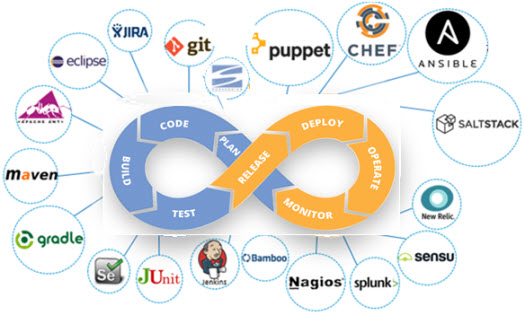
DevOps
Yaanar started DevOps practice with a vision to provide automation in building enterprise applications. By using multiple tools, we bring in a collaboration in between development, operations and testing. We have deployed required tools that helps you in implementing fully-automated, build compatible with various platforms, different sets of unit tests, user access tests, and debugging.
We use DevOps tools to:
Yaanar IT Staffing Practise covers the key functional and technical areas. Our capabilities include:
- ◾ Code — Code development and review, version control tools, code merging.
- ◾ Build — Continuous integration tools, build status.
- ◾ Test — Test and results determine performance.
- ◾ Package — Artifact repository, application pre-deployment staging.
- ◾ Release — Change management, release approvals, release automation.
- ◾ Configure — Infrastructure configuration and management, Infrastructure as Code tools.
- ◾ Monitor — Applications performance monitoring, end–user experience.
If you are looking to:
- ◾ Reduce the timeframe of release cycles.
- ◾ Want your team to focus on product innovation.
- ◾ Want to meet the demanding requirements of high availability, security, analytics and monitoring.
Why Devops?
- ◾ Speeds up deployment of products/services.
- ◾ Mitigates risky deployments and release rollbacks.
- ◾ Minimizes time and effort for error recovery.
- ◾ Eliminates integration and configuration hurdles.
- ◾ Ensuring common operating environment.
- ◾ Improves collaboration between development and ops teams.
- ◾ Brings down wastage and reduces opportunity cost.
Yaanar Expertise Service in DevOps
Yaanar offers enterprise scale tools and technical services in cloud along with 24*7 support for your continous delivery.
Consulting
If you are a start-up or of a bigger team regardless of size, we help you in assessing your present infra and we will offer you easy-to-use architecture solution and tools to ensure a seamless deployment process.
Deployment
Subscription of tools and services based on your requirements. Our team will work on swift deployment of your project in the platform and configure the tools for DevOps process.
Delivery
Subscription of tools and services based on your requirements. Our team will work on swift deployment of your project in the platform and configure the tools for DevOps process.
Our Methodology
Continuous Development:
- ◾ This is the stage in the DevOps life cycle where the Software is developed continuously. Unlike the Waterfall model the software deliverables are broken down into multiple sprints of short development cycles, developed and then delivered in a very short time. This stage involves the Coding and Building phases and makes use of tools such as Git and SVN for maintaining the different versions of the code, and tools like Ant, Maven, Gradle for building / packaging the code into an executable file that can be forwarded to the QAs for testing.
Continuous Development:Continuous Testing:
- ◾ It is the stage where the developed software is continuously tested for bugs. For Continuous testing automation tools like Selenium, JUnit etc are used. These tools enables the QA’s for testing multiple code-bases thoroughly in parallel to ensure that there are no flaws in the functionality. In this phase use of Docker containers for simulating testing environment on the fly, is also a preferred choice. Once the code is tested, it is continuously integrated with the existing code.
Continuous Development:Continuous Testing :
- ◾ This is the stage where the code supporting new functionality is integrated with the existing code. Since there is continuous development of software, the updated code needs to be integrated continuously as well as smoothly with the systems to reflect changes to the end users. The changed code, should also ensure that there are no errors in the runtime environment, allowing us to test the changes and check how it reacts with other changes. Jenkins is a very popular tool used for Continuous Integration. Using Jenkins one can pull the latest code revision from GIT repository and produce a build which can finally be deployed to test or production server. It can be set to trigger a new build automatically as soon as there is change in the GIT repository or can be triggered manually on click of a button.
Continuous Development:Continuous Testing :
- ◾ This is a very crucial stage in the DevOps life cycle which is aimed at improving the quality of the software by monitoring its performance. This practice involves the participation of the Operations team who will monitor the user activity for bugs / any improper behavior of the system. This can also be achieved by making use of dedicated monitoring tools which will continuously monitor the application performance and highlight issues. Some popular tools used are Nagios, New Relic and Sensu. These tools help you monitor the application and the servers closely to check the health of the system proactively. They can also improve productivity and increase the reliability of the systems, reducing IT support costs. Any major issues found could be reported to the Development team so that it can be fixed in the continuous development phase.
